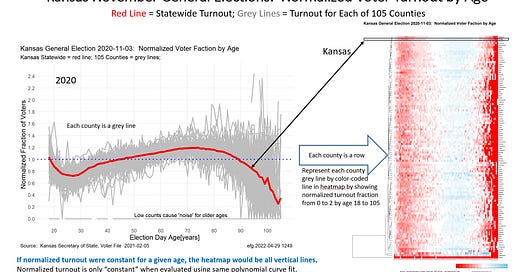Kansas election turnout NOT controlled by "algorithm"
Concerns about Dr. Douglas Frank's election analysis in Kansas and Ohio
Updated Aug. 30, 2023.
Mike Lindell and Dr. Douglas Frank should be commended for their dedication to free and fair elections in the United States.
Their claims this morning at the Lindell Election Summit in Springfield, MO about how elections are “controlled” by an algorithm (specifically a 6th-degree polynomial) are NOT supported by voting history data in Kansas and Ohio, and likely other states.
Lindell’s well-intentioned focus on “defense” to protect elections is ignoring the huge and well-organized progressive “offense” that is funded by dark money sent to “non-profits” involved in elections.
Kansas and other states are being overwhelmed by national sources of progressive political money funding progressive organizations that are focused on voter registration and advance mail ballots. This progressive “offense” will outperform existing conservative “defense.” Conservatives need a new game plan to compete.
I support Lindell’s goal of election protection. But the story told by the data must be accurate. I likely will become a pariah with conservatives for reporting this, but the truth must be told.
At the conference (18:40 in the video, “Evidence of Algorithms”):
“The percentage of 37-year olds that voted in Carver county [Minnesota] in the 2020 election was the same as every single county in Minnesota … Every county was the same.”
This article shows this was not true in Kansas and Ohio in the 2020 election.
Same turnout by age in a state across all counties?
Dr. Frank claims turnout for a given age is controlled by an “algorithm” and is constant throughout a state for an election.
See details in Concerns about Dr. Frank’s Election Analysis in this deck of 24 slides.
Raw turnout by age below shows the number of registered voters (grey line), the number of active voters (black line), and the number of voters casting ballots (red line) in Kansas general elections from 2006 to 2020.
These raw turnout curves are similar but different for each election. These “raw” curves can be “normalized” to aid comparisons.
“Normalized” turnout is a way to compare precincts, counties or a state with very different sizes on the same plot.
The normalized turnout curves for Kansas for November general elections from 2006 through 2020 are shown below.
The red lines above shows the state composite turnout. The grey lines show the turnout curves for the 105 Kansas counties.
Turnout is slightly different in different parts of the state. If the turnout were the same by age statewide, there would be a single curve above, not 106.
See details about Kansas November General Election Turnout, 2020-11-03 in these 20 slides:
Normalized Turnout Curves for Kansas and Ohio Counties, Nov. 2020 Election
Dr. Frank claims turnout for a given age is constant and “controlled” by a 6th-degree polynomial “algorithm” statewide.
His claim says voter turnout for a given age is the same in all counties. If that were true, all counties would have the same turnout curves. The data does NOT show this.
Kansas
Turnout varies for each of the 105 Kansas counties as shown below for the Nov. 2020 election.
The grey lines on the left below shows there is considerable variability across counties by age. There is not a single turnout curve. There is one red line for the state consolidated numbers, and 105 separate grey curves for each county.
Likewise, if turnout were constant for a given age, the dendrogram at the right below would be a series of vertical lines each with the same color. That is NOT present in the data.
Johnson County, KS
Likewise, turnout varies for each of nearly 500 voting precincts within Johnson County.
There is not a single turnout curve for the state, county or the precincts. The plot at the left below shows the county curve in red and the precinct curves in grey.
The dendrogram at the right below generally has few vertical “constant” lines for a given age across all precincts. The older ages show some vertical “red” lines since turnout for those 90 or above is well-below the composite normalized turnout.
Ohio
The results in Ohio (Dr. Frank’s home state) are much like seen in Kansas, by state and county. If the turnout were the same across the state, there would be a single turnout curve at the left below, and vertical lines of the same color in the dendrogram plot.
See details about Ohio Election Analysis of Nov 2020 Results in these 25 slides:
Reproducible Research
I support “reproducible research” by publishing all analysis details in computational notebooks, which can be studied by anyone.
Find these notebooks and other information in a GitHub Repository: Normalized Election Turnout. This repository has been online since Oct. 2022.
Postscript
I sent Dr. Frank an email with a link to this article asking to discuss it with him. I have not received a reply.
















Dr. Frank's claim that every single county in the US moves in lockstep with a 6th degree polynomial (whether that polynomial changes by county or state I don't remember) implies that every single county is crooked. That doesn't seem possible.
He needs to lay out the evidence more clearly. He said in a speech to the Kansas legislature that others had asked him to "explain it to them like they were kindergartners". Well he needs to explain it to others like they have PhDs (or at least masters degrees) so they can check and comment.
Thank you for cranking out the numbers and checking.
Thanks for putting this out Earl. I agree with your analysis and I think the weakness in Johnson County's election process stemmed, not from a controlling algorithm, but rather poor controls around mail in voting. Those weak controls in 2020 and 2021 included signature verification, poorly monitored drop boxes, separating the ballot from the accompanying ballot envelope, and failures in the best practice for retrieving ballots. I know that since then, 3 of those 4 issues have been cleaned up to some degree, but continued citizen vigilance is needed.